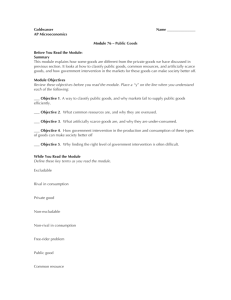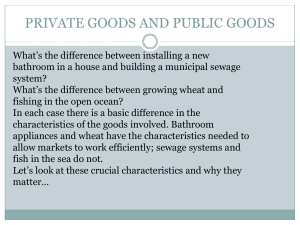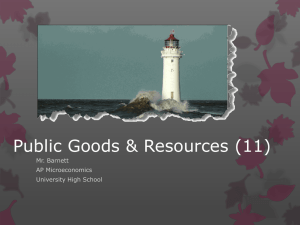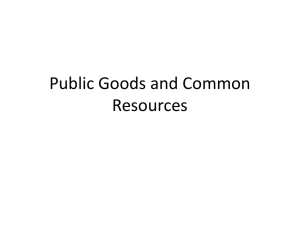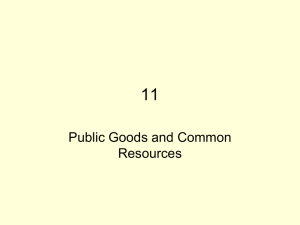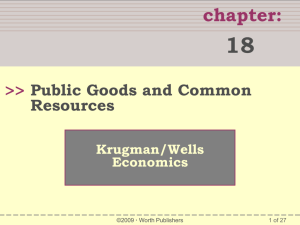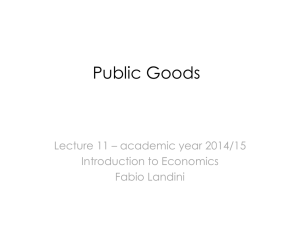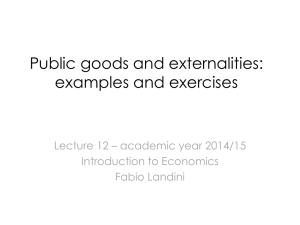Public / Private Goods and Common Resources PPT
advertisement
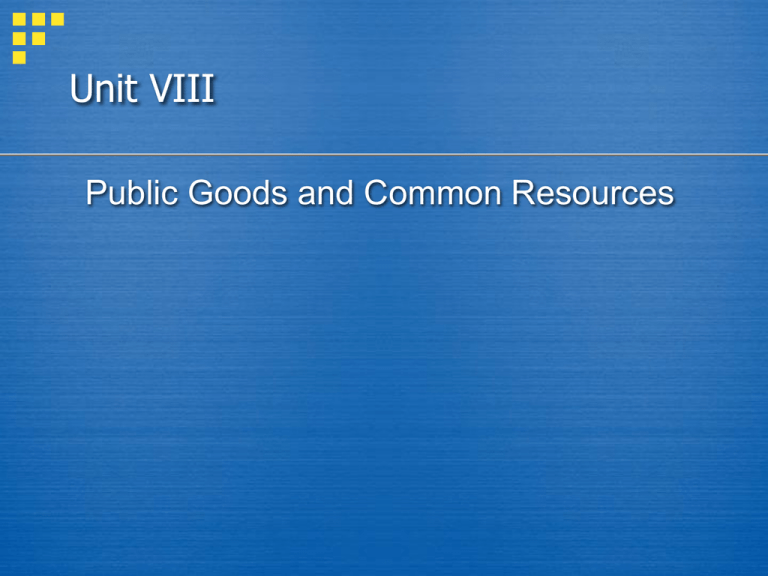
Unit VIII Public Goods and Common Resources In this chapter, look for the answers to these questions: What are public goods? What are common resources? Give examples of each. Why do markets generally fail to provide the efficient amounts of these goods? How might the government improve market outcomes in the case of public goods or common resources? Introduction • We consume many goods without paying: parks, national defense, clean air & water. • When goods are free, the market forces that normally allocate resources are absent. • The private market may fail to provide the socially efficient quantity of such goods. • Governments can sometimes improve market outcomes. Important Characteristics of Goods • A good is excludable if a person can be prevented from using it. – excludable: Wahoo fish tacos, dsl internet service – not excludable: FM radio signals, national defense • A good is rival in consumption if one person’s use of it diminishes others’ use. – rival: Wahoo fish tacos – not rival: An MP3 file of Metallica’s greatest hits The Different Kinds of Goods Private goods: excludable, rival in consumption example: food Public goods: not excludable, not rival example: national defense Common resources: rival but not excludable example: fish in the ocean Natural monopolies: excludable but not rival example: cable TV A C T I V E L E A R N I N G 1: Categorizing roads • A road is which of the four kinds of goods? • Hint: The answer depends on whether the road is congested or not, and whether it’s a toll road or not. Consider the different cases. A C T I V E L E A R N I N G 1: Answers • Rival in consumption? Only if congested. • Excludable? Only if a toll road. • Four possibilities uncongested non-toll road: public good uncongested toll road: natural monopoly congested non-toll road: common resource congested toll road: private good Classifying Goods and Resources The Different Kinds of Goods • This chapter focuses on public goods and common resources. • For both, externalities arise because something of value has no price attached to it. • So, private decisions about consumption and production can lead to an inefficient outcome. • Public policy can potentially raise economic well-being. Public Goods • Public goods are difficult for private markets to provide because of the free-rider problem. • Free rider: a person who receives the benefit of a good but avoids paying for it – If good is not excludable, people have incentive to be free riders, because firms cannot prevent non-payers from consuming the good. • Result: The good is not produced, even if buyers collectively value the good higher than the cost of providing it. Public Goods • If the benefit of a public good exceeds the cost of providing it, govt should provide the good and pay for it with a tax on people who benefit. • Problem: Measuring the benefit is usually difficult. • Cost-benefit analysis: a study that compares the costs and benefits of providing a public good • Cost-benefit analyses are imprecise, so the efficient provision of public goods is more difficult than that of private goods. Some Important Public Goods • National defense • Knowledge created through basic research • Fighting poverty The Marginal Benefit of a Public Good •The benefit a public good provides is the value of its services. •Because security lights in a common parking area are nonrival and nonexcludable, they are a public good. – Everyone consumes the same quantity of them. •To find the economy-wide value of the security lights, we add together the marginal benefits of everyone who benefits from them. Public Goods and the Free Rider Problem How to find an economy’s MB curve. Lisa’s marginal benefit curve is MBL. Max’s marginal benefit curve is MBM. The MB curve for the economy is the vertical sum of the marginal benefit curves of everyone in the economy—Lisa and Max. Public Goods and the Free Rider Problem •The Marginal Cost of a Public Good – Marginal cost increases as the quantity of a public good produced increases -- the principle of increasing marginal cost – So the marginal cost curve of public good slopes upward. Public Goods and the Free Rider Problem •The Efficient Quantity of a Public Good – resources are used efficiently if marginal benefit equals marginal cost – if marginal benefit exceeds marginal cost, resources can be used more efficiently by increasing the quantity produced – if marginal cost exceeds marginal benefit, resources can be used more efficiently by decreasing the quantity produced. Public Goods and the Free Rider Problem The efficient quantity of a public good -surveillance satellites. 1. If MB exceeds MC, an increase in the quantity will make resource use more efficient. 2. If MC exceeds MB, a decrease in the quantity will make resource use more efficient. Public Goods and the Free Rider Problem 3. If MB equals MC, resource use is efficient. 4. The efficient quantity is 200 satellites. 5. Private provision leads to underproduction—in the extreme, to zero production. Public Goods and the Free Rider Problem • Private Provision: Underproduction – no one would have an incentive to buy his or her share of the satellite system -- the free-rider problem – So a private firm would not supply satellites • Public Provision: Efficient Production The political process determines the quantity of a public good provided—this quantity might be efficient or inefficient. Common Resources • Like public goods, common resources are not excludable. – cannot prevent free riders from using – little incentive for firms to provide – role for govt: seeing that they are provided • Additional problem with common resources: rival in consumption – each person’s use reduces others’ ability to use – role for govt: ensuring they are not overused The Tragedy of the Commons • A parable that illustrates why common resources get used more than is socially desirable. • Setting: a medieval town, where sheep graze on common land. • As the population grows, the # of sheep grows. • The amount of land is fixed, the grass begins to disappear from overgrazing. • The private incentives (using the land for free) outweigh the social incentives (using it carefully). • Result: People can no longer raise sheep. The Tragedy of the Commons • The tragedy is due to an externality: Allowing one’s flock to graze on the common land reduces its quality for other families. • People neglect this external cost, resulting in overuse of the land. Common Resources • Achieving an Efficient Outcome – harder to achieve an efficient use of a common resource than to define the conditions under which it occurs – Three methods in use are: • Property rights • Quotas • Individual transferable quotas (ITQs) Common Resources • Property Rights – By assigning property rights, common property becomes private property. – When someone owns a resource, the owner is confronted with the full consequences of her/his actions in using that resources. – The social benefits become the private benefits. Common Resources • the marginal social benefit curve, MSB, becomes the marginal private benefit curve • resource is used efficiently because the owner of the resource is best off when MSB equals MC. Common Resources Quotas •By setting a production quota at the efficient quantity, a common resource might remain in common use but be used efficiently. •It is hard to make a quota work. Common Resources • Individual Transferable Quotas – An individual transferable quota (ITQ) is a production limit that is assigned to an individual who is free to transfer the quota to someone else. – A market emerges in ITQs. – If the efficient quantity of ITQs is assigned, the market price of a quota confronts resource users with a marginal cost that equals MSB at the efficient quantity. Common Resources Situation with an efficient number of ITQs Marginal cost rises from MC0 to MC1. Users of the resource make marginal private benefit, MPB, equal to marginal private cost, MC1, and the outcome is efficient. Some Important Common Resources • Clean air and water • Congested roads • Fish, whales, and other wildlife CASE STUDY: “You’ve Got Spam!” • Spam e-mail is a service some firms use to advertise their products. • Spam is not excludable: Firms cannot be prevented from spamming. “Spam” email is named after everyone’s favorite delicacy. • Spam is rival: As more companies use spam, it becomes less effective. • Thus, spam is a common resource. • Like most common resources, spam is overused – which is why we get so much of it! CONCLUSION • Public goods tend to be under-provided, while common resources tend to be over-consumed. • These problems arise because property rights are not well-established: – Nobody owns the air, so no one can charge polluters. Result: too much pollution. – Nobody can charge people who benefit from national defense. Result: too little defense. • The govt can potentially solve these problems with various policy options. CHAPTER SUMMARY A good is excludable if someone can be prevented from using it. A good is rival in consumption if one person’s use reduces others’ ability to use the same unit of the good. Markets work best for private goods, which are excludable and rival in consumption. Markets do not work well for other types of goods. CHAPTER SUMMARY Public goods, such as national defense and fundamental knowledge, are neither excludable nor rival in consumption. Because people do not have to pay to use them, they have an incentive to free ride, and firms have no incentive to provide them. Therefore, the government provides public goods, using cost-benefit analysis to determine how much to provide. CHAPTER SUMMARY Common resources are rival in consumption but not excludable. Examples include common grazing land, clean air, and congested roads. People can use common resources without paying, so they tend to overuse them. Therefore, governments try to limit the use of common resources.
